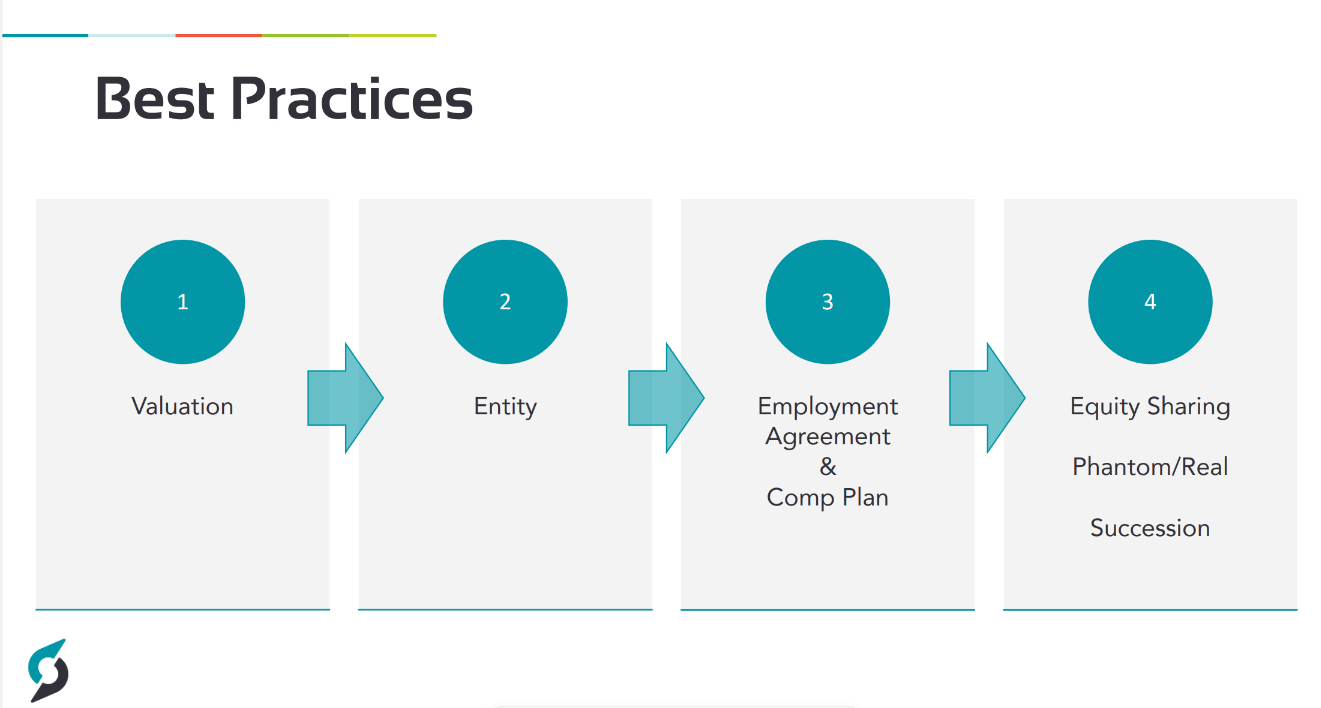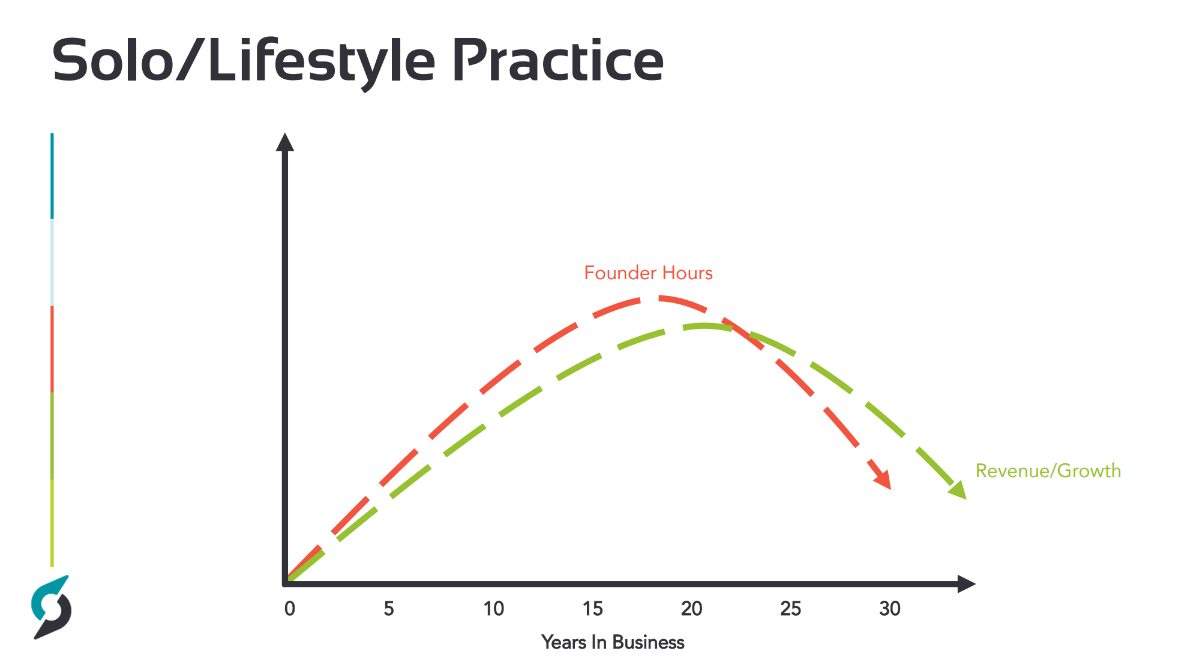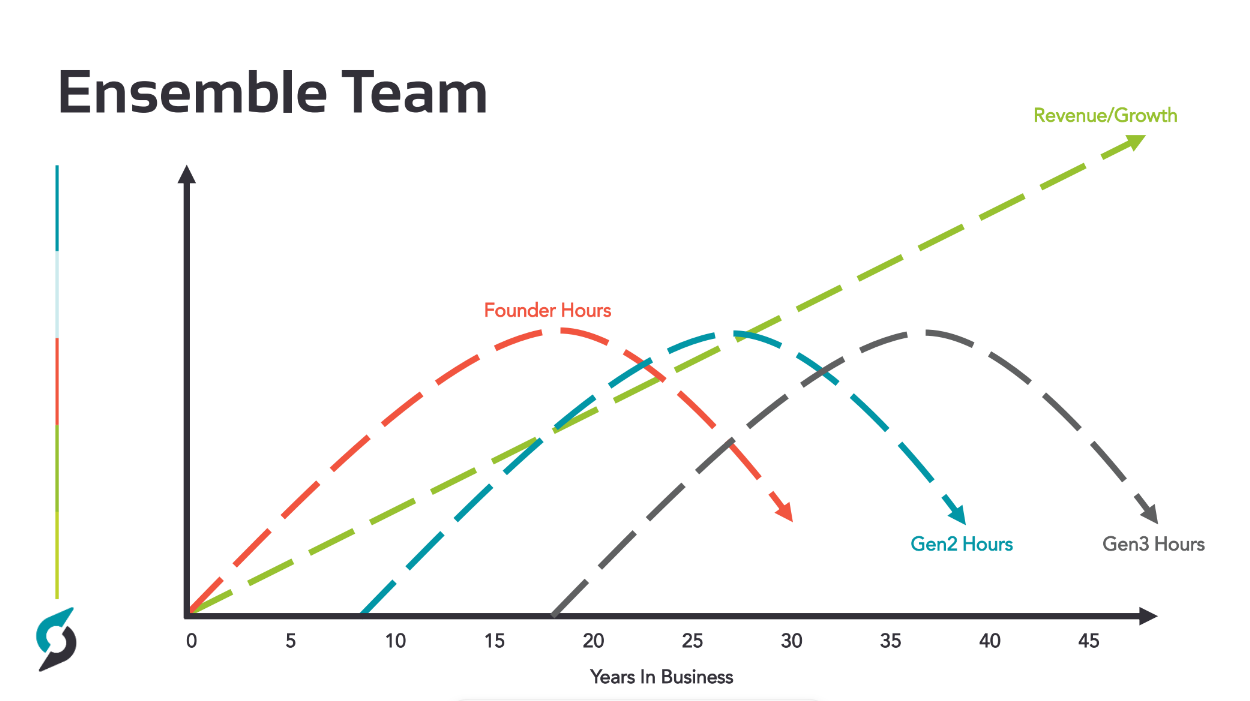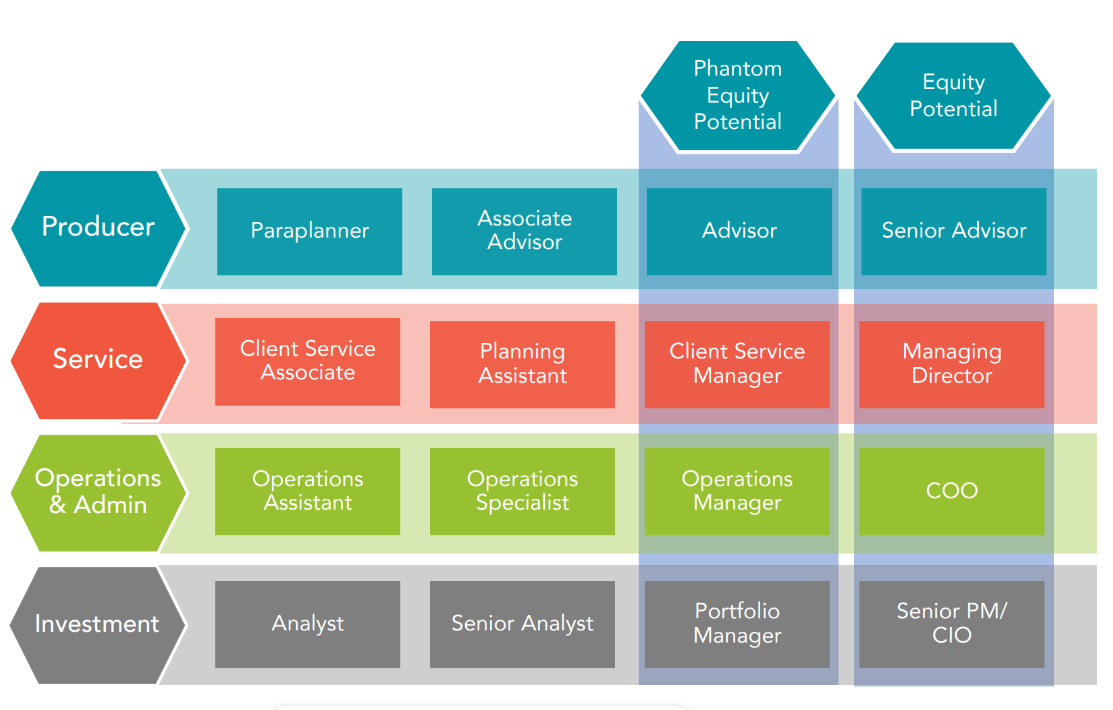Building a successful independent financial advisory firm that can support the firm’s key stakeholders is a significant accomplishment. But building a successful firm is the first milestone, not the end of the journey. Once the firm is established and stabilized, the next milestone should be to create a sustainable enterprise. This goes beyond figuring out the service and pricing model, attracting and retaining loyal clients, solid branding, and a trustworthy reputation.
Said another way, the next milestone, for those ready to embark on the journey from a practice to a business, and a business to an enterprise, is succession planning. In this context, succession planning isn’t about the founder selling and retiring. Instead, business succession strategies are focused on making the founder irrelevant. Succession planning is about creating an enterprise that can and will exist someday independent of its founders. Here's why every advisor needs to proactively prepare their teams and get the business succession strategy in motion early.
Proactive Internal Succession Prep
The chief focus of succession plans is to create a sustainable enterprise that will live on past its founders. Yes, this will also enable the founder to extract hard-earned value from the business as they sell equity to the next generation, but that comes later and is the byproduct of being a good steward of the business. As a founder, the goal should be creating a sustainable business that accounts for all the stakeholders affected: co-founders/owners and their families, successors and their families, the employees and their families, and the clients. Owners need to proactively plan to ensure the business can thrive without them someday, and in proactively thinking about their succession plan, advisors will also end up modeling optimal behaviors and truly maximizing the business’s value.
This entails internal preparations farther in advance than many owners expect. Succession planning actually happens at two different levels within any firm – occurring by design or by default at a macro AND a micro level.
-
At a macro level, succession planning is focused on the transition of ownership from one generation to another. This encompasses a fair amount of complexity, addressing the timeline and goals of the founders and next-gen team members, valuation, financing, tax strategies, cash flow, market predictions, etc. But this is only part of the recipe for success.
-
At a micro level, succession planning is focused on each person/role inside the firm and ensuring there is training and mentoring happening so that when someone vacates a role, there is someone trained and ready to step into that role, allowing the firm to meet its commitments uninterrupted.
These internal preparations at the micro succession level aren't nearly as talked about or exciting as the bigger macro level considerations, but they are no less important, and in fact, are the most critical factor for long-term success and sustainability.

Events in a Succession Planning Timeline
Succession planning is not an event, or even a series of events. Succession planning is a mindset. When founders are conscious of this, it impacts how and who they hire, their organizational planning, budgeting, goals, training and mentoring – all facets of the business are impacted when an owner/founder is intentionally building a firm designed to exist independent of themselves. Even knowing that most advisors/owners enjoy serving clients and working with their team, eventually they will slow down and exit, and in the meantime, as they continue to grow, servicing the new clients will require us to “clone” the founder and create other lead advisors. With enough growth, advisors/founders can quickly find themselves spending more time managing and training than they do sitting in front of clients. The goal of proactive succession planning is to manage this process so the business works for the owner, not the other way around.
Even with the retirement lens, slowing down isn't the same "cliff retirement" many of our parents and grandparents had, where they had a retirement party, got the gold watch, and then one day stopped coming to the office. By figuring out the timeline, priorities, and exit options in advance, owners can focus on staffing, training and mentoring strategically so that as they do slow down, the business doesn’t. While succession planning and managing it at the micro and macro levels does take work, it is far better than simply relying on a random third party to come in and save the day when the owner is ready to retire. By having a timeline and plan, owners can ensure the next generation of advisors is prepared while also enabling themselves to have a series of liquidity events that are manageable for the team.
Succession isn't just "What will I do when I'm ready to exit?" The business succession strategy becomes more about “growing” than “going.” At a high level, there are a handful of common ways that advisors exit the industry, and each is worth consideration to understand what strategy aligns with the business and founder’s goals.
➡️ Extended Reading: Powerful Succession Planning Tools You Need
Common Business Succession Options
Business succession structures can take different forms, some of which focus more on short-term relief than long-term growth and profitability. Here are the benefits and drawbacks of the common forms of business succession for financial advisors:
-
Retire through attrition: Also called the "die at your desk" model, many advisors opt for it out of simplicity. It's a better alternative than abruptly announcing the advisor’s retirement and stopping everything they’re doing, and also allows them to stretch out the income for many years as the practice gradually declines. The biggest advantage to retiring through attrition is the flexibility and ease. The owner simply does nothing – they gradually stop investing in the business, referrals stop coming in, and they no longer spend time/money on prospecting. There are no buyers to interview or negotiate with, no staff that must be trained, nor any complicated contracts to read. However, it is categorically the worst option/outcome for the clients. Life events, changes in the markets, and regulatory changes often upend these plans earlier than expected.

-
Sell to a peer: This option has several palpable benefits, like a ready and willing market, though the current seller market that has been in place since the early 2000s is already beginning to soften. Planning to sell to a peer does not take as much time or preparation as an internal sale, but it does still require planning to ensure a smooth handoff occurs and that the founder is able to achieve a fair value. This option is much harder to plan proactively for because it can bring many unpredictable changes to the staff and clients and is reliant on a single, usually unknown party when the founder is precariously close to being ready to retire. This move can provide a quick payout, a great buyer/successor, and continued employment for the team, but finding and negotiating the best deal with the best buyer isn’t as easy as talking to a few known peers and seeing who might be interested (which is the path many unwittingly choose).
-
Sell to an aggregator: Industry aggregators are a great option for those who have built a sustainable enterprise and either become bogged down with running the firm and are unable to grow or enjoy the business or find themselves in a position where the next generation on the team either does not have the interest or ability to buy-out the founders. For most, the major players in the aggregator space won’t be an option due to the aggregator’s size/scale requirements for prospects, but for some, the ability to partner with these larger organizations or completely exit can be a lifesaver. But, this typically creates a significant amount of change, and getting a fair value from such a skilled buyer is more challenging than most expect.
-
Sell internally: Selling the business gradually to the team that was trained and mentored by the founder is the desired exit strategy for most. But, it requires being patient and proactive, as well as investing the time and effort (and money) in the next generation with no guarantee of success. This method provides more flexibility for founders with regard to the timeline and other aspects of the succession plan. Planning for internal sales is also an incredible retention tool for top-performing team members. While a typical succession plan to transfer ownership may take no less than 5-7 years, the transition of trust with the clients, as well as the mentoring, training, documenting processes, etc., can take 10+ years.

The most formidable succession strategy is one that is premeditated. Whether the owner sells internally or to a peer, or auctions the business off to the best candidate, the goal is to proactively plan and build the business to capitalize on the intended path. Streamlining the business and maximizing profits can be an excellent option when planning for a third-party sale or merger, but would prove counterproductive if the goal is internal succession. Similarly, one would not want to hire additional staff, sign a new lease for a larger office, and ramp up the technology stack right before listing the practice for sale.
➡️ Extended Reading: Leveraging Your Growth: Equity Compensation Strategies for Advisors
Succession Success Starts with Formalizing the Entity
The foundation of any succession plan is establishing the right business entity. Not only does it provide important tax and legal aspects, but the entity also serves as the ultimate equity-sharing tool when the time comes.
It's crucial to ensure that the business entity is set up correctly for the long term and that the structure aligns with the growth plans. This means reviewing or redoing things like the governance documents to ensure they address the necessary protections for the founder(s) and future owners, that there are appropriate valuation and buy-out/buy-back provisions, that voting has been carefully considered, that the ownership classes are appropriate for the future growth plans, and a dozen other considerations. Done right, one can maintain the flexibility of a partnership, while enjoying the tax savings of a corporation. As part of the entity planning work and potential equity sharing at some point, it is critical to ensure that firms understand the value of their business in advance of needing to use a valuation.
Prep for Succession with a Strong Valuation
The value of a financial service business is something that most owners are generally aware of, but few understand the intricacies of what drives or detracts from value, and even less understand just how broad the range of values observed in the market actually is. The valuation multiples, for example, vary widely for a practice ranging from 1.6x to as high as 4.4x revenue. For an enterprise, the multiples are just as diverse, but the focus shifts to profitability instead of revenue, consistently ranging between 5-12x earnings. Everyone wants a high valuation for their firm, but it is important, regardless of who an owner sells to, to have a realistic understanding of the firm’s value from a neutral third party with experience in the industry. There are a variety of valuation methods that an expert can and will employ based on the size and type of the firm, as well as the intended use case (internal succession planning versus a 3rd party sale for example). The valuation is key to making informed decisions, strategically working to increase the value, and is used for financing should the buyer(s) need external capital.

How Human Resources Ties Into Succession
The core internal preparations for building a successful business are a lot like the foundation of a house. If the foundation isn’t well thought out, the house is likely to collapse as it is expanded or requires major retrofitting, which is both time-consuming and expensive. Most of these preparations are from a human resources standpoint, in that the firm doesn't just need a sufficient headcount but the right types of heads.
Finding and Keeping the Right Successors for Your Business
With everything an owner has to do to ensure their firm is prepared for succession, the best place to start is with the timeline:
- When they want to be able to materially cut back their hours and have the successors take on more responsibilities; and
- When they want to be able to exit the firm and retire.
While these dates will likely remain fluid, putting a “flag in the ground” to start with allows all
parties to begin working backward on the timeline and create a starting place for expectations and when the transition of roles and responsibilities should realistically begin. When the owner(s) understands the timeline, they can then begin to evaluate the current team and its readiness to take on more of the owner’s responsibilities.
Most founders become reasonably adept at all facets of the business out of necessity early on, and then begin to narrow their focus in the business as they are able to afford to hire or outsource the administrative parts of the business. As the business continues to grow and evolve, the business’s needs also change – benefiting from specialists who are excellent at a few things. Because of this, it is common to see a ratio of two to three successors for everyone one founder. But, shifting the duties from one or two founders who were the jack-of-all-trades to a handful of specialists is what will allow the firm to reach its next evolution and continue to scale. This highlights the need for long-term vision as every hire is then done to fill a current role/need as well as potentially playing a key role as a next-gen leader. When the focus is building an enterprise that is sustainable, the firm will hire, mentor, and train differently.
Hiring and building a next-gen team is like planting and watering seeds; some of the seeds will germinate right away and flourish, occasionally the firm may find a transplant that is fully grown and ready to go, some may sprout much later unexpectedly, and some may do nothing at all. It is because of this that one must be intentional about their hiring and training decisions, do so earlier than most expect, and be consistent over the decades. Most advisors know someone who has spent time and money to train their successor, only to have this person leave years later and take clients with them, leaving the founder and firm in a quandary. For growing firms, multiple successors will likely be needed, and it is reasonable to expect that not every hire will work out. But, through diversifying the firm’s talent pool and having multiple successor candidates already part of the long-term plan, these occasional missteps become opportunities to upgrade talent and get rid of folks early enough that the succession plan isn’t impacted.
Use Human Capital to Build a Strong Succession Plan
As a firm grows, attracting and retaining quality talent becomes a priority. The most successful firms carefully monitor their org. chart both for where the firm and needs are today, but also looking into the future and what the org. chart and needs are going to be in 2-3 years when their growth goals are reached. As the org. chart is changing and evolving, so too are the job descriptions and compensation plans. As the jobs change and become narrower in scope, the pay scales for each role are also changing. It seems as if the ancient Greek philosopher Heraclitus was speaking directly to business owners when he said, “The only constant is change.”
Hiring people with a broad array of skills is almost a requirement in the early stages of the business lifecycle. Everyone must wear multiple “hats” depending on the day. For those set on shifting from a practice to a business or an enterprise, hiring a generalist is a temporary necessity, but they are looking for folks who have the propensity to be great in one area when it is needed.
Without even trying, growing firms find the need to divide one person’s role into two or three. For example, when an advisor leaves a wirehouse and starts his/her practice, they will often bring their assistant with them. The assistant will answer the phones, order supplies, help with meeting prep, arrange the client appreciation events, sit in on meetings and take notes, and do a dozen other random tasks. With enough new money coming in from new and existing clients, this person is being pulled in too many directions to be effective, and they are asked to compartmentalize their simplest/least impactful duties and hire/train a replacement, allowing the assistant to focus on their highest and best use of time. Assuming team members have the desire and skills to continue to narrow their expertise and grow with the firm, this gradual narrowing of roles and constant mentoring and training is the core of a sustainable business. This model really hits its stride when founders reach the point where they have trained the key people and roles, and those team members have taken the tutelage and improved on the role (because they get to focus on one area, where the founder was doing fifty things), and they are now training their replacements/subordinates independent of the founder.
This focus on increased specialization results in a number of benefits beyond just making the firm more sustainable and prepared for succession. The firm has an easier time recruiting talent, they tend to keep their existing talent longer (career tracks are a major contributor), they are harder to compete with given the robust group of specialists that come together, they become more efficient, and it is harder for any one team member to leave and take clients given the integrated team approach of amazing people.
Unfortunately, working to build a sustainable enterprise also means these firms are never done hiring and recruiting. They are always on the hunt for new talent; the question is, where does this talent generally come from? Recruiting has been the historical answer for most – pay a recruiter to go find ready-made talent that can start producing immediately. While this can work, it is unpredictable and expensive. Rather than relying on recruitment as the primary means to acquire talent, build a "farm team" of talent and promote from within. While this takes time, it is the best way to fill empty seats and maintain the culture of the organization. Investing in entry-level employees doesn't just prepare them for their immediate roles, continuing to invest in their careers will support retention and set them up as potential next-gen leaders.
Mentorship and a feeling of ownership are critical to keeping employees engaged in the firm's growth. Team-based compensation plans tailored to each employee's role and strengths are highly effective. This means getting away from the pure revenue-based compensation models that are designed to motivate lead advisors to build their own books of business. Employees are motivated by various things based on the individual, but pay is always one of the key elements and thus requires time and attention to ensure the compensation model is competitive and aligns with the role and overall company culture. Equity is often used as part of the compensation plan in recent years, thus worth consideration. Sharing equity is a great retention tool and creates unique incentives for employees, but it is also important to ensure the primary operating entity for the company is set up appropriately and designed to accommodate additional owners.
Mistakes to Avoid When Planning Succession
As we said before, succession planning isn't an event. Done right, succession planning is a mindset that one builds the business with. Succession will involve sales of equity, incrementally or all at once, but when planned for in advance, succession can be far more than just the mechanics of the deal. There are numerous things one can do to optimize their outcome, but only a few major mistakes to avoid:
1. Don't wait too long. The more time we give succession, the more the clients, staff, and owners will enjoy the process. Even if the plan is to run the business and then eventually sell it to the highest bidder, starting the process early enough that the founder could work part-time for at least a year or two before fully stepping away can add substantial value for a buyer. The longer an owner holds off, the fewer options there are and the more difficult and stressful it gets.
2. Don't give it away. Some owners feel compelled to sell their practice at a discount because of the loyalty their team has shown, or because they simply don’t “need” the money. Owners that don’t need the money are still better off getting paid the fair market value of their business and then giving some of the proceeds away to their favorite charity, to their children, or some other worthy cause, as opposed to effectively giving that money to the buyer.
3. Don't lose sight of the priorities. Have reasonable expectations and create a plan that makes sense for both personal and professional priorities. When those priorities are established and discussed with the key stakeholders, work to stick to them. It is easy to get distracted by the myriad of considerations that owners face, and combined with the human element of succession planning, some make concessions that they later regret.
Plan for Succession Early with Trusted Advice
Succession planning is of the utmost importance for all business owners – but given the value of a financial service business, this “asset” is often one of the most valuable things an advisor owns. As discussed previously, the firms with the highest and best valuations are those that focus on creating a sustainable enterprise, an enterprise that can operate day-to-day without the owner/founders. While this may be aspirational for some, even the attempt at building the enterprise will still generally result in building a better and more saleable firm. This entails proactively planning for the founder's retirement, but also on all the necessary activities leading up to that series of events. Hiring, training, and mentoring the next generation, then grooming them as they move up through the career track, all become core differentiators.


